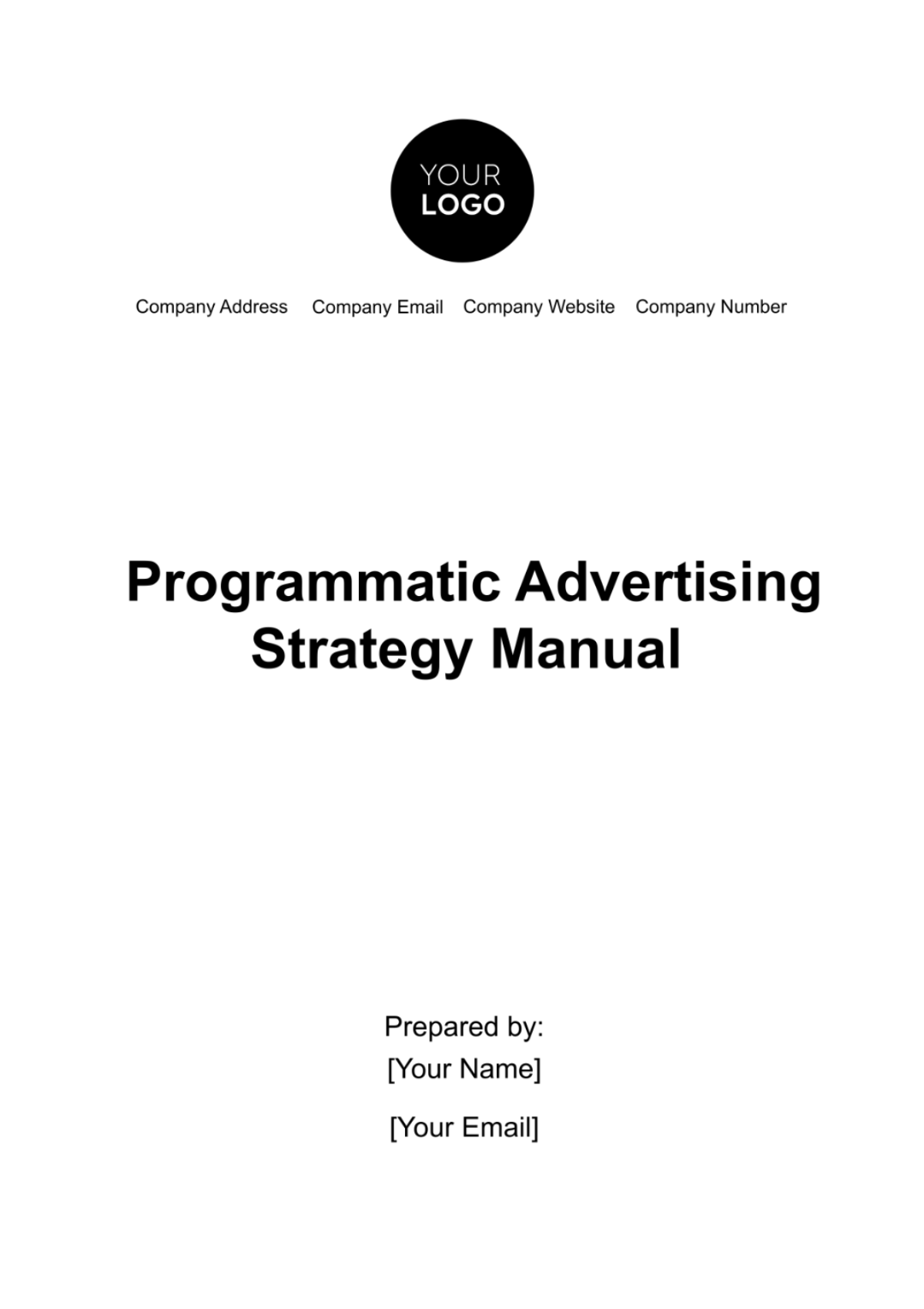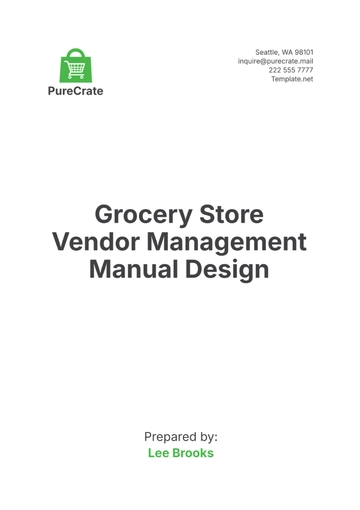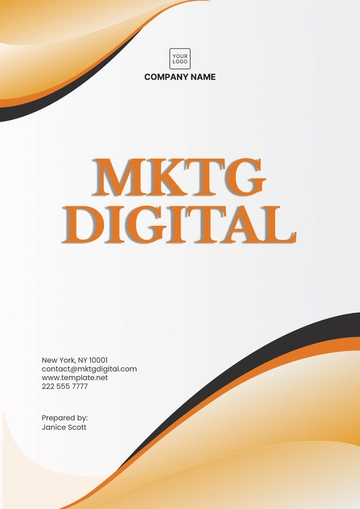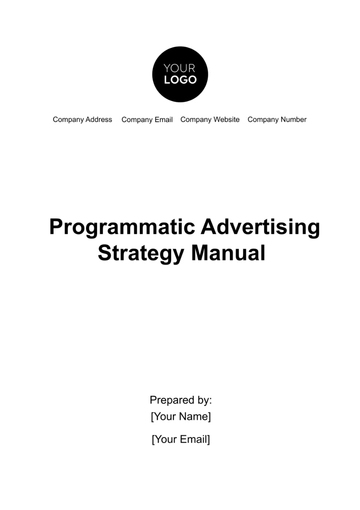Free Programmatic Advertising Strategy Manual

I. Introduction to Programmatic Advertising
Programmatic advertising represents a revolutionary shift in digital marketing and for [Your Company Name], marking the transition from traditional, manual ad buying to an automated, data-driven approach. This technology-enabled method leverages complex algorithms and machine learning to purchase display space, making decisions based on user behavior and real-time data.
By doing so, it significantly enhances the efficiency and effectiveness of online advertising campaigns. The core advantage of programmatic advertising lies in its ability to use rich data insights to target specific audiences with precision, ensuring that the right ads are delivered to the right people at the right time. This not only optimizes the advertiser's budget but also improves the overall user experience, as audiences are more likely to engage with content that is relevant and personalized.
Evolution of Programmatic Advertising
The evolution of programmatic advertising involves continuous innovation and adaptation. Initially, online ad space was bought and sold through direct deals between advertisers and publishers, a process that was often time-consuming and lacked precision. The advent of programmatic advertising brought with it the promise of efficiency and accuracy, utilizing technology to automate these transactions. Over time, this field has witnessed significant advancements, evolving from basic automated auctions to sophisticated strategies that now incorporate real-time bidding and advanced targeting techniques.
Today, programmatic advertising stands at the forefront of digital marketing and [Your Company Name], driven by advancements in artificial intelligence and machine learning, allowing for more nuanced and effective ad placements than ever before.
II. Understanding Programmatic Platforms
Delve into the functionalities and significance of Demand-Side Platforms (DSPs), Supply-Side Platforms (SSPs), Data Management Platforms (DMPs), and Ad Exchanges. Each of these platforms plays a unique and pivotal role in the automated landscape of digital advertising, empowering advertisers and publishers with advanced tools for efficient and effective ad transactions.
A. Demand-Side Platforms (DSPs)
Demand-Side Platforms (DSPs) are a cornerstone of programmatic advertising, serving as sophisticated software platforms that enable advertisers and agencies to buy ad inventory from multiple ad exchanges and networks through a single interface. DSPs are equipped with advanced targeting capabilities, allowing advertisers to specify the kind of audience they want to reach, based on various criteria like demographics, interests, online behavior, and more. They also provide real-time bidding capabilities, enabling advertisers to bid on ad space in real-time, ensuring optimal use of their advertising budget. The integration of data analytics within DSPs further empowers advertisers with insights into campaign performance, enabling continuous optimization and refinement of their advertising strategies.
B. Supply-Side Platforms (SSPs)
Supply-Side Platforms (SSPs) are the publisher's counterpart to DSPs. These platforms enable publishers to manage and sell their digital ad inventory across multiple networks and exchanges efficiently. SSPs utilize algorithmic selling to maximize revenues by selling ad space to the highest bidder in real-time. This not only ensures higher profitability for publishers but also contributes to the optimization of ad space utilization. SSPs provide publishers with control over which ads appear on their sites, helping to maintain the quality and relevance of displayed advertisements, which is crucial for preserving user experience and brand integrity.
C. Data Management Platforms (DMPs)
Data Management Platforms (DMPs) are pivotal in the programmatic ecosystem, serving as centralized warehouses for the collection, organization, and analysis of large sets of structured and unstructured data from various sources. DMPs integrate with both DSPs and SSPs, providing them with valuable data that can be used to refine targeting strategies and improve campaign performance. They collect data from a variety of sources, including first-party data (from the advertiser’s own sources), third-party data (from external sources), and campaign data, to create detailed audience profiles. These profiles enable advertisers to segment and target audiences more effectively, leading to more personalized and successful advertising campaigns.
D. Ad Exchanges
Ad Exchanges are digital marketplaces that play a critical role in the programmatic advertising ecosystem, acting as intermediaries between buyers (advertisers) and sellers (publishers). They facilitate the buying and selling of ad inventory in real-time through a bidding system, similar to a stock exchange. Ad exchanges provide a platform where SSPs and DSPs can interact, with SSPs offering ad inventory from multiple publishers and DSPs buying this inventory on behalf of advertisers. This process ensures a fair and efficient marketplace, where ad space is priced according to real-time demand, benefiting both publishers and advertisers by optimizing the value of each ad impression.
III. Types of Programmatic Buying
This critical section of the manual illuminates the nuances and strategic applications of Real-Time Bidding (RTB), Private Marketplaces (PMPs), and Programmatic Direct buying. RTB brings the dynamism of auction-based buying, offering high-speed, impression-level bidding, while PMPs provide an exclusive environment where premium ad inventory is traded among select advertisers and publishers. Programmatic Direct, on the other hand, offers a more controlled approach with pre-negotiated, guaranteed ad placements.
A. Real-Time Bidding (RTB)
Real-Time Bidding (RTB) is a dynamic auction-style process that forms the backbone of modern programmatic buying. In RTB, ad impressions are bought and sold on a per-impression basis, with transactions occurring within milliseconds as a webpage loads. This section delves deeply into the mechanics of RTB, illustrating how it enables advertisers to bid for ad space in real-time, with the highest bidder winning the right to display their ad to a specific user. This method offers unparalleled efficiency and precision in ad targeting, as advertisers can evaluate each impression based on user data and decide on its value in real-time. RTB offers a level of granularity in targeting and optimization that traditional advertising methods cannot match, ensuring that ad budgets are spent on reaching the most relevant audience, thereby maximizing the return on investment.
B. Private Marketplace (PMP)
Private Marketplaces (PMPs) offer a more controlled environment within the programmatic landscape. They are exclusive, invite-only marketplaces where selected publishers offer premium ad inventory to a pre-approved group of advertisers. This section explores the unique characteristics of PMPs, highlighting how they blend the efficiency of programmatic buying with the assurance of premium, brand-safe environments. For publishers, PMPs provide the opportunity to monetize their inventory at higher rates by offering it to a select group of advertisers who value the specific audience and content alignment. For advertisers, PMPs offer the advantage of accessing premium inventory in a less competitive environment than open RTB auctions, allowing for more strategic ad placements and potentially higher engagement rates.
C. Programmatic Direct
Programmatic Direct is a streamlined approach to buying ad space, where advertisers purchase inventory directly from publishers, bypassing the auction-based mechanisms of RTB and PMPs. This section discusses the benefits of Programmatic Direct, particularly for advertisers looking for more predictability and control in their ad placements. Unlike RTB, Programmatic Direct allows for the purchase of guaranteed ad inventory, providing advertisers with assured visibility and publishers with stable revenue. This method is particularly suited for long-term campaigns where consistent ad placement on specific sites is desired. Programmatic Direct combines the efficiency and data-driven approach of programmatic advertising with the reliability of traditional direct buying, making it an attractive option for both publishers and advertisers who prioritize brand alignment and consistent audience reach.
IV. Targeting Strategies in Programmatic Advertising
Explore the multifaceted approaches to targeting, including audience targeting, contextual targeting, behavioral targeting, and geo-targeting. Understanding these targeting strategies is essential for advertisers seeking to optimize ad relevance and engagement, thereby maximizing the impact and ROI of their programmatic advertising efforts.
A. Audience Targeting
Audience targeting in programmatic advertising is a sophisticated approach to identifying and reaching specific groups of potential customers. This strategy segments audiences based on a variety of criteria such as demographics (age, gender, income level), interests (hobbies, preferences), and behaviors (online activities, purchase history).
B. Contextual Targeting
Contextual targeting represents a significant facet of programmatic advertising, where ads are placed based on the content of a web page rather than user behavior. Contextual targeting is based on the premise that ads related to the content being consumed are more likely to resonate with the audience.
C. Behavioral Targeting
Behavioral targeting in programmatic advertising leverages user activity data to deliver ads that are relevant to their recent behavior on the internet. This approach involves analyzing users' browsing history, search queries, and online purchase behavior to create a detailed profile of their interests and preferences.
D. Geo-Targeting
Geo-targeting is a critical strategy in programmatic advertising where ads are served to users based on their geographic location. This tactic can be as broad as targeting users in a particular country or as specific as targeting a neighborhood or even a store.
V. Creating Effective Programmatic Ad Campaigns
The success of a programmatic advertising campaign is deeply rooted in its creation and execution. This is a crucial section that guides you through the foundational steps of crafting a programmatic advertising strategy that resonates with your target audience and achieves your marketing goals.
A. Campaign Objectives and Goals
Establishing clear and measurable objectives is the most important foundation for any successful programmatic advertising campaign. This section emphasizes the importance of setting realistic and achievable goals that align with the broader marketing strategy of the brand. Objectives can range from increasing brand awareness and generating leads to driving sales and improving customer loyalty.
The key is to define these objectives in measurable terms, such as a specific percentage increase in website traffic or a targeted number of conversions. This clarity allows for the precise tracking of campaign performance and provides a benchmark against which success can be measured. Additionally, well-defined objectives guide the selection of targeting strategies, creative elements, and bidding tactics, ensuring a cohesive and focused campaign approach.
B. Creative Strategy
The creative strategy in programmatic advertising plays a pivotal role in engaging the audience and achieving campaign objectives. This chapter delves into the development of ad creatives that capture attention and resonate with the target audience. It discusses the importance of aligning creative elements with the brand’s identity and campaign goals, ensuring a consistent and impactful message.
Emphasis is placed on the importance of A/B testing various creative elements to understand what resonates best with the audience, allowing for continuous optimization of the creative strategy for maximum engagement and conversion.
C. Budgeting and Bidding
Navigating the complexities of budgeting and bidding is essential for maximizing the return on investment in programmatic advertising. [Your Company Name]’s teams must outline effective strategies for allocating budgets across different aspects of a programmatic campaign, including ad creatives, targeting, and media buying, discussing the importance of setting a budget that reflects campaign objectives and market realities, ensuring sufficient resources are allocated to reach the desired audience effectively.
VI. Data and Analytics in Programmatic Advertising
Data and analytics form the backbone of decision-making and campaign optimization. This section unveils the power of data-driven strategies in enhancing ad performance. This segment is designed to equip you with the analytical prowess necessary to transform raw data into actionable insights. Whether fine-tuning current campaigns or planning future strategies, this section is your guide to harnessing the full potential of data in the dynamic landscape of programmatic advertising.
A. Key Performance Indicators (KPIs)
Key Performance Indicators (KPIs) are crucial metrics that provide insights into the effectiveness of a programmatic advertising campaign. This section outlines the essential KPIs necessary to measure the success of programmatic campaigns. These KPIs typically include click-through rates (CTR), conversion rates, cost per acquisition (CPA), viewability rates, and return on ad spend (ROAS). Each of these indicators offers valuable information about different aspects of campaign performance, from audience engagement to financial efficiency.
B. Data Analysis
Effective data analysis is integral to understanding and enhancing the performance of programmatic advertising campaigns. This part of the manual delves into the techniques and methodologies used in analyzing campaign data. It emphasizes the importance of collecting and interpreting data to gain insights into audience behavior and campaign effectiveness. Additionally, it highlights the importance of integrating data from multiple sources, including first-party data, third-party data, and real-time campaign metrics, to create a holistic view of campaign performance.
C. Optimization Strategies
Continuous optimization is a critical aspect of programmatic advertising, ensuring that campaigns remain effective and efficient over time. This chapter focuses on strategies for optimizing programmatic campaigns based on the insights gathered from data analysis. It discusses various optimization approaches, including real-time bidding adjustments, audience segmentation refinement, and creative rotation. It also covers the use of machine learning algorithms and automation tools in optimizing bids, targeting, and ad placements.
VII. Programmatic Advertising Compliance and Ethics
A. Privacy Laws and Regulations
Adherence to privacy laws and regulations is not just a legal requirement but also a cornerstone of consumer trust. This section offers a comprehensive overview of pivotal privacy regulations such as the General Data Protection Regulation (GDPR) in Europe and the California Consumer Privacy Act (CCPA) in the United States. These laws have significant implications for how personal data is collected, processed, and used in programmatic advertising.
Understanding these laws is essential for advertisers and publishers to ensure compliance and avoid hefty penalties. This part of the manual also discusses the importance of obtaining explicit consent from users, responsibly handling data, and being transparent about data usage practices. Additionally, it covers the privacy regulations across different regions and how to implement compliant strategies in programmatic advertising campaigns.
B. Ethical Considerations
Ethical considerations in programmatic advertising go beyond legal compliance; They are about fostering trust and maintaining a positive brand reputation. They discuss the importance of honesty and transparency in advertising messages, avoiding misleading content, and respecting user preferences.
Ethical considerations also explore the ethical implications of data use in targeting and personalization, emphasizing the need to balance effective marketing with respect for user privacy and ethical considerations, advocating for responsible advertising practices that prioritize user experience and promote trust, which are crucial for long-term brand success.
VIII. Brand Safety
Brand safety is a critical concern in programmatic advertising, as ads may inadvertently appear alongside inappropriate or harmful content, potentially damaging the brand's reputation. This chapter outlines strategies to ensure that ads are displayed in safe and appropriate contexts. It discusses the use of technology and tools to filter and control ad placements, including blacklists, whitelists, and contextual targeting technologies.
It also highlights the importance of partnering with reputable ad networks and publishers and continuously monitoring ad placements to quickly address any issues that arise. By implementing these brand safety measures, advertisers can protect their brand integrity and maintain consumer trust, which is paramount in today's digital advertising environment.
IX. Emerging Trends and Future of Programmatic Advertising
Keeping pace with the latest trends is crucial for maintaining a competitive edge. This section provides an in-depth look at the current developments reshaping the landscape of programmatic advertising. Key trends include the increasing use of artificial intelligence and machine learning for more sophisticated targeting and bidding strategies, the rise of connected TV (CTV) and over-the-top (OTT) advertising as consumers shift towards streaming services, and the growing emphasis on data privacy and consent-driven advertising in response to regulatory changes.
Another significant trend is the adoption of blockchain technology for greater transparency and fraud prevention in ad transactions. Additionally, the section examines the impact of 5G technology on mobile advertising, enabling faster and more engaging ad experiences. Understanding these trends helps advertisers and publishers adapt their strategies to leverage new opportunities and address emerging challenges in the programmatic advertising space.
X. Case Studies and Best Practices
Each case study dissects a different campaign, examining the initial objectives, strategies employed, challenges faced, and the outcomes achieved. These examples span various industries and target audiences, providing a comprehensive view of the versatility and effectiveness of programmatic advertising.
Key takeaways from each campaign are highlighted, offering valuable lessons on effective targeting, creative strategy, budget management, and data utilization. These case studies serve as a source of inspiration and learning, demonstrating innovative approaches and best practices in programmatic advertising.
Drawing from the case studies and industry experiences, this part of the manual synthesizes best practices in programmatic advertising. It compiles a list of actionable insights and lessons learned that can be applied to future campaigns. Topics covered include the importance of aligning campaign goals with business objectives, the effectiveness of data-driven targeting, the impact of creative design on engagement, and the necessity of ongoing optimization and testing.
XI. Conclusion
The Programmatic Advertising Strategy Manual serves as a valuable resource for advertisers, offering insights and actionable strategies to enhance the efficiency and effectiveness of programmatic advertising campaigns, ultimately driving better results in the dynamic digital advertising landscape.
- 100% Customizable, free editor
- Access 1 Million+ Templates, photo’s & graphics
- Download or share as a template
- Click and replace photos, graphics, text, backgrounds
- Resize, crop, AI write & more
- Access advanced editor
Empower your advertising strategy with Template.net's Programmatic Advertising Strategy Manual Template. This editable and customizable resource, powered by our AI Editor Tool, simplifies the creation of effective programmatic advertising strategies. Tailor your approach to target audiences, optimize campaigns, and maximize ROI effortlessly. Stay ahead in the advertising landscape with our innovative solutions.





























